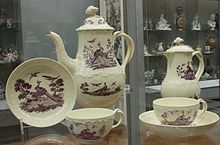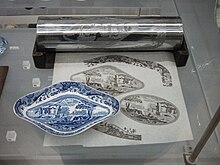
Back Impresión por transferencia Galician Transferni tisak Croatian Stampa a trasferimento termico Italian 전사 프린터 Korean Impressão por transferência Portuguese Transfer baskı Turkish



Transfer printing is a method of decorating pottery or other materials using an engraved copper or steel plate from which a monochrome print on paper is taken which is then transferred by pressing onto the ceramic piece.[1] Pottery decorated using this technique is known as transferware or transfer ware.
It was developed in England from the 1750s on, and in the 19th century became enormously popular in England, though relatively little used in other major pottery-producing countries. The bulk of production was from the dominant Staffordshire pottery industry. America was a major market for English transfer-printed wares, whose imagery was adapted to the American market; several makers made this almost exclusively.
The technique was essential for adding complex decoration such as the Willow pattern to relatively cheap pottery. In particular, transfer printing brought the price of a matching dinner service low enough for large numbers of people to afford.
Apart from pottery, the technique was used on metal, and enamelled metal, and sometimes on wood and textiles. It remains used today, although mostly superseded by lithography. In the 19th century methods of transfer printing in colour were developed.
- ^ Fleming, John & Hugh Honour. (1977) The Penguin Dictionary of Decorative Arts. London: Allen Lane, p. 800. ISBN 0713909412